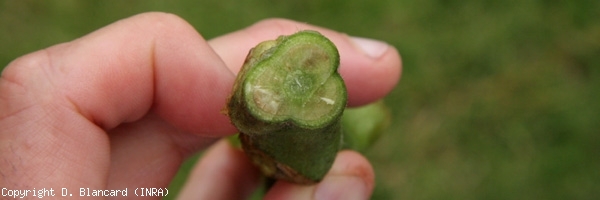
Verticillium white-black Reinke & Berthold, (1879)
- Classification: Fungi, Basidiomycota, Lichinomycetes, Hypocreomycetidae, Incertae_sedis_, Plectosphaerellaceae
- téléomorphe : Plectosphaerellaceae
- English name: Verticillium wilt
Verticillium dahliae , a highly polyphagous fungus , has been reported on tomato in many producing countries in temperate and subtropical zones . It affects several hundred herbaceous and woody host plants, and in particular several other nightshades: tobacco, potatoes, peppers and especially eggplant, which is particularly sensitive. On tomatoes, its incidence may have been significant in the past, it is now zero in countries where resistant varieties are used. This is currently the case in France , except if new varieties intended for soilless or old ones without resistance to this vascular disease are cultivated.
A race 2. 1 , able to circumvent the resistance to verticillium conferred by the gene " fifth " has been reported in several countries. The same is true for V. albo-atrum .
Of the two species of Verticillium can attack tomato, V. dahliae is the most reported, particularly in France. A limited number of vegetative compatibility groups (VCG) has been demonstrated in this species: VCG 1, VCG 2 (including VCG 2A and VCG 2B), VCG 3 and VCG 4 (including VCG 4A, 4B and 4AB). Another group has been proposed, which could be included in VCG 4. In addition, an isolate could be the only one to belong to a new VCG 5 group. We should add that several isolates from pepper have recently been associated with another new VCG group 6 .
Note that in Japan, the nomenclature of GBV is different, and 3 subgroups have been differentiated: J1, J2 and J3, without knowing their relationship with the other groups defined previously.
For example, in Israel, isolates from the VCG 2A group are the most aggressive on tomato, compared to isolates from the VCG 4 and VCG 2B groups. Those of group VCG 1, aggressive on cotton, would not be pathogenic on tomato. Let us add that the pathogenicity of V. dahliae seems to vary according to the strain studied, its host of origin and its compatibility group. Certain strains present a certain parasitic specificity.
Another species, V. albo-atrum , is also reported. Unlike the previous species, it does not form microsclerotia and its thermal optima are lower. However, isolates of the latter Verticillium would have revealed higher thermal optima in Tunisia.
Isolates of V. tricorpus , pathogenic on potatoes and particularly aggressive on tomato and eggplant have been detected in Tunisia. This species produces fairly dark preservative chlamydospores and mycelium, in addition to microsclerotia.
1. The nomenclature of the races of Verticillium dahliae employed is not always conventional. Race 1 would actually be race 0, race 2 would normally be named "race 1".





